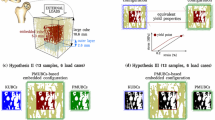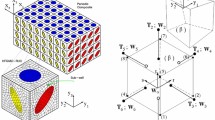Abstract
Computational analysis of trabecular bone normally involves the modeling of (experimental tests of) cored samples. However, the lack of constraint on the sides of the extracted trabecular bone samples limits the information that can be inferred regarding true in situ behavior. Here, the element-by-element voxel-based finite element method was applied via, a custom-written software suite (FEEBE), to a 72 μm resolution model of an ovine vertebra. The difference between the apparent modulus of eight concentric core cylinders when modeled as part of the whole bone (containing 84 × 106 degrees of freedom) and independent of the whole bone was investigated. The results showed that cored trabecular bone apparent modulus depended significantly on the core diameter when modeled as an extracted core (r 2 = 0.975) and as part of a whole bone (r 2 = 0.986). The cause of this result was separated into the side-artifact effect and bone volume fraction (BV/TV) effect. For the independently modeled cores, the apparent modulus of an inner core region of interest varied with increasing thickness of the outer annulus. This was attributed to the side-artifact effect, given that the BV/TV of the core region was constant. Within the whole trabecular structure, the side artifact was eliminated as the entire bone structure was modeled. However, a BV/TV effect influenced the apparent modulus depending on the size of the core selected for determining apparent modulus. Changing the size of the core varied the overall BV/TV of the core, and this significantly (r 2 = 0.999) influences the apparent modulus. Therefore, determining a ‘true’ apparent modulus for trabecular bone was not achievable. The independently modeled cores consistently under-predict the in vivo apparent modulus. It is recommended that if a ‘true’ apparent modulus is required, the BV/TV at which it is required needs to be first determined. Apparent modeling of entire bones at microscale resolution allowed regions of low and high tissue strains to be identified, consistent with patterns of trabecular bone remodeling and resorption reported in literature. The basivertebral vein cavity underwent the highest strains within the entire vertebral body, suggesting that failure might initiate here, despite containing visibly thicker struts and plate trabeculae. Although computationally expensive, analysis of the entire vertebral body provided a full picture of in situ trabecular bone deformation.
Similar content being viewed by others
References
Banse X, Devogelaer JP et al (2001) Inhomogeneity of human vertebral cancellous bone: systematic density and structure patterns inside the vertebral body. Bone 28: 563–571
Bayraktar HH, Keaveny TM (2004) Mechanisms of uniformity of yield strains for trabecular bone. J Biomech 37: 1671–1678
Bayraktar H, Adams MF et al (2004a) Micromechanics of the human vertebral body. 50th Annual Meting of the Orthopaedic Research Society, San Francisco, USA
Bayraktar HH, Morgan EF et al (2004b) Comparison of the elastic and yield properties of human femoral trabecular and cortical bone tissue. J Biomech 37: 27–35
Bevill G, Easley SK et al (2007) Side-artifact errors in yield strength and elastic modulus for human trabecular bone and their dependence on bone volume fraction and anatomic site. J Biomech 40: 3381–3388
Crawford RP, Cann CE et al (2003a) Finite element models predict in vitro vertebral body compressive strength better than quantitative computed tomography. Bone 33: 744–750
Crawford RP, Rosenberg WS et al (2003b) Quantitative computed tomography-based finite element models of the human lumbar vertebral body: effect of element size on stiffness, damage, and fracture strength predictions. J Biomech Eng 125: 434–438
Dolan P, Adams MA (2001) Recent advances in lumbar spinal mechanics and their significance for modelling. Clin Biomech 16: S8–S16
Eswaran SK, Keaveny TM (2006) Failure mechanisms of the human vertebral body. 52nd Annual meeting of the Orthopaedic Research Society, Chicago, USA
Eswaran SK, Gupta A et al (2006) Cortical and trabecular load sharing in the human vertebral body. J Bone Miner Res 21: 307–314
Eswaran SK, Allen MR et al (2007a) A computational assessment of the independent contribution of changes in canine trabecular bone volume fraction and microarchitecture to increased bone strength with suppression of bone turnover. J Biomech 40: 3424–3431
Eswaran SK, Bayraktar HH et al (2007b) The micro-mechanics of cortical shell removal in the human vertebral body. Comput Methods Appl Mech Eng 196: 3025–3032
Goh S, Price RI et al (1999) The relative influence of vertebral body and intervertebral disc shape on thoracic kyphosis. Clin Biomech 14: 439–448
Gong H, Zhang M et al (2007) Regional variations in the apparent and tissue-level mechanical parameters of vertebral trabecular bone with aging using micro-finite element analysis. Ann Biomed Eng 35: 1622–1631
Gray H (1995) Gray’s anatomy: the anatomical basis of medicine and surgery. Churchill Livinstone, London
Guldberg RE, Hollister SJ et al (1998) The accuracy of digital image-based finite element models. J Biomech Eng 120: 289–295
Harrigan TP, Jasty M et al (1988) Limitations of the continuum assumption in cancellous bone. J Biomech 21: 269–275
Harrison NM (2007) Small and large deformation modelling of trabecular bone based on the voxel finite element method. PhD Thesis, Department of Mechanical and Biomedical Engineering, National University of Ireland Galway, Galway
Harrison NM, McDonnell PF et al (2008) Heterogeneous linear elastic trabecular bone modelling using micro-CT attenuation data and experimentally measured heterogeneous tissue properties. J Biomech 41: 2589–2596
Homminga J, McCreadie BR et al (2003) The dependence of the elastic properties of osteoporotic cancellous bone on volume fraction and fabric. J Biomech 36: 1461–1467
Homminga J, Van-Rietbergen B et al (2004) The osteoporotic vertebral structure is well adapted to the loads of daily life, but not to infrequent error loads. Bone 34: 510–516
Horst M, Brinckmann P (1981) Measurement of the distribution of axial stress on the end-plate of the vertebral body. Spine 6: 217–232
Keaveny TM, Borchers RE et al (1993) Trabecular bone modulus and strength can depend on specimen geometry. J Biomech 26: 991–995
Keaveny TM, Pinilla TP et al (1997) Systematic and random errors in compression testing of trabecular bone. J Orthop Res 15: 101–110
Keyak JH, Rossi SA et al (1997) Prediction of femoral fracture load using automated finite element modeling. J Biomech 31: 125–133
Kim D-G, Hunt HA et al (2006) The effect of regional variations of the trabecular bone properties on the compressive strength of human vertebral bodies. 51st Annual Meeting of the Orthopaedic Research Society, Washington, DC
Kosmopoulos V, Schizas C et al (2008) Modeling the onset and propagation of trabecular bone microdamage during low-cycle fatigue. J Biomech 41: 515–522
Kumaresan S, Yoganandan N et al (1999a) Finite element analysis of the cervical spine: a material property sensitivity study. Clin Biomech 14: 41–53
Kumaresan S, Yoganandan N et al (1999b) Finite element modeling of the cervical spine: role of intervertebral disc under axial and eccentric loads. Med Eng Phys 21: 689–700
Manns RA, Haddaway MJ et al (1996) The relative contribution of disc and vertebral morphometry to the angle of kyphosis in asymptomatic subjects. Clin Radiol 51: 258–262
Mc Donnell P, Harrison N et al (2010) Investigation of the mechanical interaction of the trabecular core with an external shell using rapid prototype and finite element models. J Mech Behav Biomed Mater 3(1): 63–76. doi:10.1016/j.jmbbm.2009.03.002
Niebur GL, Yuen JC et al (1999) Convergence behaviour of high-resolution finite element models of trabecular bone. J Biomech Eng 121: 629–635
Niebur GL, Feldstein MJ et al (2000) High-resolution finite element models with tissue strength asymmetry accurately predict failure of trabecular bone. J Biomech 33: 1575–1583
Ochia RS, Tencer AF et al (2003) Effect of loading rate on endplate and vertebral body strength in human lumbar vertebrae. J Biomech 36: 1875–1881
Odgaard A, Kabel J et al (1997) Fabric and elastic principal directions of cancellous bone are closely related. J Biomech 30: 487–495
Pahr D, Zysset P (2008) Influence of boundary conditions on computed apparent elastic properties of cancellous bone. Biomech Model Mechanobiol 7: 463–476
Pistoia W, van Rietbergen B et al (2003) Mechanical consequences of different scenarios for simulated bone atrophy and recovery in the distal radius. Bone 33: 937–945
Pollintine PBMP, Dolan PBSCP et al (2004) Intervertebral disc degeneration can lead to stress-shielding of the anterior vertebral body: a cause of osteoporotic vertebral fracture?. Spine 29: 774–782
Pothuaud L, Rietbergen BV et al (2002) Combination of topological parameters and bone volume fraction better predicts the mechanical properties of trabecular bone. J Biomech 35: 1091–1099
Qiu T-X, Tan K-W et al (2006) Investigation of thoracolumbar T12-L1 burst fracture mechanism using finite element method. Med Eng Phys 28: 656–664
Rohlmann A, Zander T et al (2006) Analysis of the influence of disc degeneration on the mechanical behaviour of a lumbar motion segment using the finite element method. J Biomech 39: 2484–2490
Silva MJ, Keaveny TM et al (1997) Load sharing between the shell and centrum in the lumbar vertebral body. Spine 22: 140–150
Simpson EK, Parkinson IH et al (2001) Intervertebral disc disorganization is related to trabecular bone architecture in the lumbar spine. J Bone Miner Res 16: 681–687
Su R, Campbell GM et al (2007) Establishment of an architecture- specific experimental validation approach for finite element modeling of bone by rapid prototyping and high resolution computed tomography. Med Eng Phys 29: 480–490
Teo JCM, Si-Hoe KM et al (2007) Correlation of cancellous bone microarchitectural parameters from microCT to CT number and bone mechanical properties. Mater Sci Eng C 27: 333–339
Terlouw MA, Rietbergen BV et al (2006) Inhomogeneity of osteoporotic human vertebral properties. 51st Annual Meeting of the Orthopaedic Research Society, Washington, DC
Thomsen JS, Ebbesen EN et al (2000) A new method of comprehensive static histomorphometry applied on human lumbar vertebral cancellous bone. Bone 27: 129–138
Thomsen JS, Ebbesen EN et al (2002) Zone-dependent changes in human vertebral trabecular bone: clinical implications. Bone 30: 664–669
Tyndyk MA (2005) Finite element modelling of the mechanical behaviour of the thoracolumbar spine. PhD Thesis, Department of Mechanical and Biomedical Engineering National University of Ireland, Galway, Galway, Ireland
Ulrich D, Rietbergen BV et al (1999) Load transfer analysis of the distal radius from in-vivo high-resolution CT-imaging. J Biomech 32: 821–828
Un K, Bevill G et al (2006) The effects of side-artifacts on the elastic modulus of trabecular bone. J Biomech 39: 1955–1963
van Dieen JH, Kingma I et al (2001) Stress distribution changes in bovine vertebrae just below the endplate after sustained loading. Clin Biomech 16: S135–S142
Van Rietbergen B, Huiskes R et al (2003) Trabecular bone tissue strains in the healthy and osteoporotic human femur. J Bone Miner Res 18: 1781–1788
van Rietbergen B, Weinans H et al (1995) A new method to determine trabecular bone elastic properties and loading using micromechanical finite-element models. J Biomech 28: 69–81
Verhulp E, van Rietbergen B et al (2006) Comparison of micro-level and continuum-level voxel models of the proximal femur. J Biomech 39: 2951–2957
Wolff J (1870) Uber die innere Architektur der Knochen und ihre Bedeutung fur die. Frage vom Knochenwachstum. Virchows Arch Pathol Anat 50: 389–450
Yerby SA, Bay BK et al (1998) The effect of boundary conditions on experimentally measured trabecular strain in the thoracic spine. J Biomech 31: 891–897
Yoganandan N, Pintar FA et al (2006) Trabecular bone density of male human cervical and lumbar vertebrae. Bone 39: 336–344
Author information
Authors and Affiliations
Corresponding author
Rights and permissions
About this article
Cite this article
Harrison, N.M., McHugh, P.E. Comparison of trabecular bone behavior in core and whole bone samples using high-resolution modeling of a vertebral body. Biomech Model Mechanobiol 9, 469–480 (2010). https://doi.org/10.1007/s10237-009-0188-8
Received:
Accepted:
Published:
Issue Date:
DOI: https://doi.org/10.1007/s10237-009-0188-8




